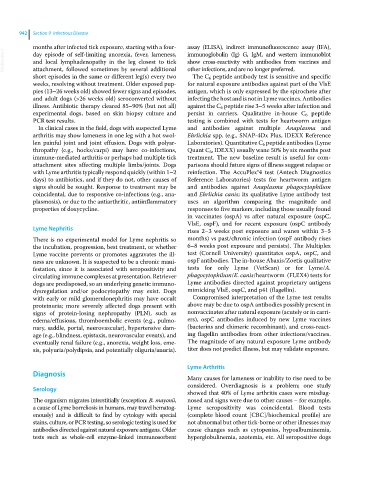Page 1004 - Clinical Small Animal Internal Medicine
P. 1004
942 Section 9 Infectious Disease
months after infected tick exposure, starting with a four‐ assay (ELISA), indirect immunofluorescence assay (IFA),
VetBooks.ir day episode of self‐limiting anorexia, fever, lameness, immunoglobulin (Ig) G, IgM, and western immunoblot
show cross‐reactivity with antibodies from vaccines and
and local lymphadenopathy in the leg closest to tick
attachment, followed sometimes by several additional
The C 6 peptide antibody test is sensitive and specific
short episodes in the same or different leg(s) every two other infections, and are no longer preferred.
weeks, resolving without treatment. Older exposed pup for natural exposure antibodies against part of the VlsE
pies (13–26 weeks old) showed fewer signs and episodes, antigen, which is only expressed by the spirochete after
and adult dogs (>26 weeks old) seroconverted without infecting the host and is not in Lyme vaccines. Antibodies
illness. Antibiotic therapy cleared 85–90% (but not all) against the C 6 peptide rise 3–5 weeks after infection and
experimental dogs, based on skin biopsy culture and persist in carriers. Qualitative in‐house C 6 peptide
PCR test results. testing is combined with tests for heartworm antigen
In clinical cases in the field, dogs with suspected Lyme and antibodies against multiple Anaplasma and
arthritis may show lameness in one leg with a hot swol Ehrlichia spp. (e.g., SNAP‐4Dx Plus, IDEXX Reference
len painful joint and joint effusion. Dogs with polyar Laboratories). Quantitative C 6 peptide antibodies (Lyme
thropathy (e.g., hocks/carpi) may have co‐infections, Quant C 6 , IDEXX) usually wane 50% by six months post
immune‐mediated arthritis or perhaps had multiple tick treatment. The new baseline result is useful for com
attachment sites affecting multiple limbs/joints. Dogs parisons should future signs of illness suggest relapse or
with Lyme arthritis typically respond quickly (within 1–2 reinfection. The AccuPlex®4 test (Antech Diagnostics
days) to antibiotics, and if they do not, other causes of Reference Laboratories) tests for heartworm antigen
signs should be sought. Response to treatment may be and antibodies against Anaplasma phagocytophilum
coincidental, due to responsive co‐infections (e.g., ana and Ehrlichia canis; its qualitative Lyme antibody test
plasmosis), or due to the antiarthritic, antiinflammatory uses an algorithm comparing the magnitude and
properties of doxycycline. responses to five markers, including those usually found
in vaccinates (ospA) vs after natural exposure (ospC,
VlsE, ospF), and for recent exposure (ospC antibody
Lyme Nephritis rises 2–3 weeks post exposure and wanes within 3–5
There is no experimental model for Lyme nephritis so months) vs past/chronic infection (ospF antibody rises
the incubation, progression, best treatment, or whether 6–8 weeks post exposure and persists). The Multiplex
Lyme vaccine prevents or promotes aggravates the ill test (Cornell University) quantitates ospA, ospC, and
ness are unknown. It is suspected to be a chronic mani ospF antibodies. The in‐house Abaxis/Zoetis qualitative
festation, since it is associated with seropositivity and tests for only Lyme (VetScan) or for Lyme/A.
circulating immune complexes at presentation. Retriever phagocytophilum/E. canis/heartworm (FLEX4) tests for
dogs are predisposed, so an underlying genetic immuno Lyme antibodies directed against proprietary antigens
dysregulation and/or podocytopathy may exist. Dogs mimicking VlsE, ospC, and p41 (flagellin).
with early or mild glomerulonephritis may have occult Compromised interpretation of the Lyme test results
proteinuria; more severely affected dogs present with above may be due to ospA antibodies possibly present in
signs of protein‐losing nephropathy (PLN), such as nonvaccinates after natural exposure (acutely or in carri
edema/effusions, thromboembolic events (e.g., pulmo ers), ospC antibodies induced by new Lyme vaccines
nary, saddle, portal, neurovascular), hypertensive dam (bacterins and chimeric recombinant), and cross‐react
age (e.g., blindness, epistaxis, neurovascular events), and ing flagellin antibodies from other infections/vaccines.
eventually renal failure (e.g., anorexia, weight loss, eme The magnitude of any natural exposure Lyme antibody
sis, polyuria/polydipsia, and potentially oliguria/anuria). titer does not predict illness, but may validate exposure.
Lyme Arthritis
Diagnosis
Many causes for lameness or inability to rise need to be
considered. Overdiagnosis is a problem; one study
Serology
showed that 40% of Lyme arthritis cases were misdiag
The organism migrates interstitially (exception: B. mayonii, nosed and signs were due to other causes – for example,
a cause of Lyme borreliosis in humans, may travel hematog Lyme seropositivity was coincidental. Blood tests
enously) and is difficult to find by cytology with special (complete blood count [CBC]/biochemical profile) are
stains, culture, or PCR testing, so serologic testing is used for not abnormal but other tick‐borne or other illnesses may
antibodies directed against natural exposure antigens. Older cause changes such as cytopenias, hypoalbuminemia,
tests such as whole‐cell enzyme‐linked immunosorbent hyperglobulinemia, azotemia, etc. All seropositive dogs

